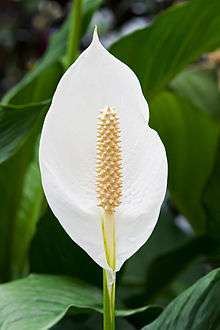Spathiphyllum cochlearispathum
Spathiphyllum cochlearispathum is a plant species of the genus Spathiphyllum in the family Araceae. It is native to southern Mexico and often cultivated.[2] When cultivated as a houseplant, Spathiphyllum cochlearispathum is commonly called Peace Lily.
| Spathiphyllum cochlearispathum | |
|---|---|
 | |
| Scientific classification | |
| Kingdom: | Plantae |
| Clade: | Tracheophytes |
| Clade: | Angiosperms |
| Clade: | Monocots |
| Order: | Alismatales |
| Family: | Araceae |
| Genus: | Spathiphyllum |
| Species: | S. cochlearispathum |
| Binomial name | |
| Spathiphyllum cochlearispathum (Liebm.) Engl. | |
| Synonyms[1] | |
|
List
| |
Taxonomic history
The species was originally described by Frederik Michael Liebmann in a separate genus Hydnostachyon, which he described as having a concave (spoon-like) spathe Spatha foliacea persistens cochleariformis, from which he formed the species epithet cochlearispathum.[3] The species was moved to the genus Spathiphyllum by Heinrich Gustav Adolf Engler.[4]
Care Instructions
Water only once soil is dry and the plant begins to wilt, then saturate the soil. The peace lily likes light, but absolutely no direct sunlight, not even for short periods.
References
- "The Plant List: A Working List of All Plant Species". Retrieved February 17, 2014.
- "Spathiphyllum cochlearispathum". Germplasm Resources Information Network (GRIN). Agricultural Research Service (ARS), United States Department of Agriculture (USDA). Retrieved 23 January 2018.
- F. Liebmann (1849). Om Mexicos Aroideer. Videnskabelige meddelelser fra den Naturhistoriske forening i Kjöbenhavn. Made available online by The Biodiversity Heritage Library. pp. 11–25.
- Heinrich Gustav Adolf Engler (1879). Alphonse de Candolle and Casimir de Candolle (ed.). Monographiæ phanerogamarum. p. 221.
| Wikimedia Commons has media related to Spathiphyllum cochlearispathum. |


